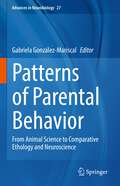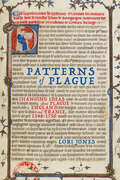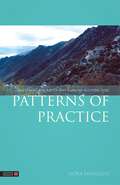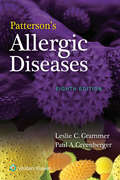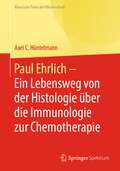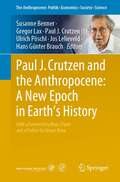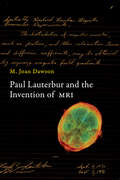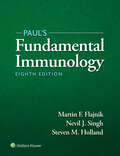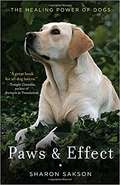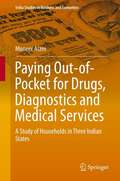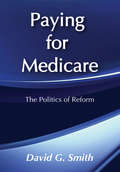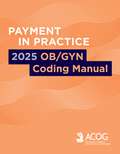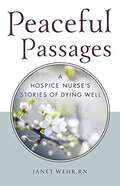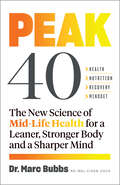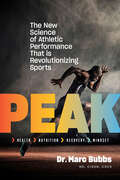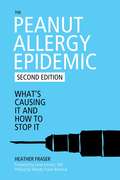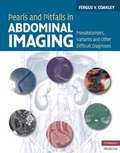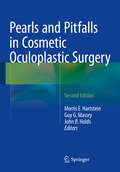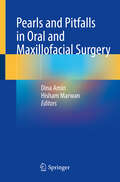- Table View
- List View
Patterns of Parental Behavior: From Animal Science to Comparative Ethology and Neuroscience (Advances in Neurobiology #27)
by Gabriela González-MariscalModern neuroscience has presented new opportunities for exploring the molecular and neural mechanisms controlling specific social responses. This book reviews insights into the neural circuits underlying a particularly fascinating form of social interaction, parental behavior. This book presents a detailed review of maternal and paternal behavior of particular mammalian species. It offer neuroscientists a spectrum of specific mammals that can be used as experimental models to explore particular topics on the functions of the nervous system. It shows that results coming from the laboratory can be translated into useful information for raising mammals on the farm, and it stimulates biologists to gain insights into the underpinnings of the complex mechanisms governing mammalian behavior in the wild. It also discusses the implications of this research for human parental behavior.
Patterns of Plague: Changing Ideas about Plague in England and France, 1348–1750 (McGill-Queen's/Associated Medical Services Studies in the History of Medicine, Health, and Society)
by Lori JonesFor centuries, recurrent plague outbreaks took a grim toll on populations across Europe and Asia. While medical interventions and treatments did not change significantly from the fourteenth century to the eighteenth century, understandings of where and how plague originated did.Through an innovative reading of medical advice literature produced in England and France, Patterns of Plague explores these changing perceptions across four centuries. When plague appeared in the Mediterranean region in 1348, physicians believed the epidemic’s timing and spread could be explained logically and the disease could be successfully treated. This confidence resulted in the widespread and long-term circulation of plague tracts, which described the causes and signs of the disease, offered advice for preventing infection, and recommended therapies in a largely consistent style. What, where, and especially who was blamed for plague outbreaks changed considerably, however, as political, religious, economic, intellectual, medical, and even publication circumstances evolved.Patterns of Plague sheds light on what was consistent about plague thinking and what was idiosyncratic to particular places and times, revealing the many factors that influence how people understand and respond to epidemic disease.
Patterns of Practice: Mastering the Art of Five Element Acupuncture
by Nora FranglenRather than simply a different version of western medical practice, acupuncture, as the author of this thoughtful and challenging book shows, is based on a different philosophy and leads down directly into the deepest areas of human experience. Based on many years as a five element practitioner, Nora Franglen explores the way in which the practice of acupuncture enlarges the experience and understanding of the practitioner. She shares, through case study and reflection, some of the larger questions and insights that emerge from a dedicated approach to this form of healing work. Her insights and astute observations will encourage acupuncturists of any style as well as other therapists to reflect on their own practices, their relationships with their patients, and their fears. They also shed further light on the expression of the five elements within us all.
Patterson's Allergic Diseases: Treatment And Prevention
by Leslie GrammerSince 1972, Patterson’s Allergic Diseases has been the go-to reference for healthcare practitioners looking for a comprehensive and practical guide to the diagnosis and treatment of allergic disorders. This eighth edition focuses on patient evaluation and management, and covers immunologic mechanisms, pathophysiology, pharmacology, and diagnostic techniques. Many contributors hail from outside the field of allergy-immunology, providing an invaluable non-specialist perspective on essential clinical practices.
Paul Ehrlich - Ein Lebensweg von der Histologie über die Immunologie zur Chemotherapie (Klassische Texte der Wissenschaft)
by Axel C. HüntelmannPaul Ehrlich war einer der bedeutendsten Lebenswissenschaftler seiner Zeit. Er hat unser heutiges Verständnis zum Ablauf immunologischer Prozesse maßgeblich geprägt. Ebenso geht die Idee der modernen Arzneimittelforschung, systematisch nach Substanzen zu suchen, ihre Wirkung auf Krankheitserreger und Zellen zu prüfen und ggf. die Zusammensetzung der Substanzen zu modifizieren, auf Paul Ehrlich zurück. Der vorliegende Band präsentiert eine Auswahl von Ehrlichs Publikationen, die das gesamte Spektrum seiner Arbeitsthemen abbilden, von seinem 1877 publizierten Artikel über die Anilinfärbungen bis zu den 1910 veröffentlichten „Schlußbemerkungen“ zum Salvarsan. Es wurden Publikationen gewählt, über die das Verbindende seiner Forschungen deutlich wird. Vorangestellt ist eine Einleitung, die den Lebensweg Paul Ehrlichs skizziert, in seine wissenschaftlichen Arbeiten einführt, die Textauswahl erläutert und die seine verschiedenen Arbeitsfelder miteinander in Bezug setzt.
Paul J. Crutzen and the Anthropocene: A New Epoch in Earth’s History (The Anthropocene: Politik—Economics—Society—Science #1)
by Hans Günter Brauch Paul J. Crutzen Susanne Benner Gregor Lax Ulrich Pöschl Jos LelieveldThis book outlines the development and perspectives of the Anthropocene concept by Paul J. Crutzen and his colleagues from its inception to its implications for the sciences, humanities, society and politics.The main text consists primarily of articles from peer-reviewed scientific journals and other scholarly sources. It comprises selected articles on the Anthropocene published by Paul J. Crutzen and a selection of related articles, mostly but not exclusively by colleagues with whom he collaborated closely.• In the year 2000 Nobel Laureate Paul J. Crutzen proposed the Anthropocene concept as a new epoch in Earth’s history • Comprehensive collection of articles on the Anthropocene by Paul J. Crutzen and his colleagues• Unique primary research literature and Crutzen’s comprehensive bibliography• Paul Crutzen’s scientific investigations into human influences on atmospheric chemistry and physics, the climate and the Earth system, leading to the conception of the Anthropocene• Reflections on the Anthropocene and its implications• Bibliometric review of the spread of the use of the Anthropocene concept in the Natural and Social Sciences, Humanities and Law
Paul Lauterbur and the Invention of MRI
by M. Joan DawsonThe story behind the invention of the most important medical diagnostic tool since the X-ray.On September 2, 1971, the chemist Paul Lauterbur had an idea that would change the practice of medical research. Considering recent research findings about the use of nuclear magnetic resonance (NMR) signals to detect tumors in tissue samples, Lauterbur realized that the information from NMR signals could be recovered in the form of images—and thus obtained noninvasively from a living subject. It was an unexpected epiphany: he was eating a hamburger at the time. Lauterbur rushed out to buy a notebook in which to work out his idea; he completed his notes a few days later. He had discovered the basic method used in all MRI scanners around the world, and for this discovery he would share the Nobel Prize for Physiology or Medicine in 2003. This book, by Lauterbur's wife and scientific partner, M. Joan Dawson, is the story of Paul Lauterbur's discovery and the subsequent development of the most important medical diagnostic tool since the X-ray.With MRI, Lauterbur had discovered an entirely new principle of imaging. Dawson explains the science behind the discovery and describes Lauterbur's development of the idea, his steadfastness in the face of widespread skepticism and criticism, and related work by other scientists including Peter Mansfield (Lauterbur's Nobel co-recipient), and Raymond Damadian (who famously feuded with Lauterbur over credit for the ideas behind MRI). She offers not only the story of one man's passion for his work but also a case study of how science is actually done: a flash of insight followed by years of painstaking work.
Paul's Fundamental Immunology
by Martin FlajnikSelected as a Doody's Core Title for 2022! Defining the field of immunology for 40 years, Paul’s Fundamental Immunology continues to provide detailed, authoritative, up-to-date information that uniquely bridges the gap between basic immunology and the disease process. The fully revised 8th edition maintains the excellence established by Dr. William E. Paul, who passed away in 2015, and is now under new editorial leadership of Drs. Martin F. Flajnik, Nevil J. Singh, and Steven M. Holland. It’s an ideal reference and gold standard text for graduate students, post-doctoral fellows, basic and clinical immunologists, microbiologists and infectious disease physicians, and any physician treating diseases in which immunologic mechanisms play a role.
Paula: A Memoir (Ave Fénix Ser. #Vol. 23)
by Isabel AllendeNewly ReissuedNew York Times Bestselling Author“Beautiful and heartrending. . . . Memoir, autobiography, epicedium, perhaps even some fiction: they are all here, and they are all quite wonderful.” —Los Angeles Times When Isabel Allende’s daughter, Paula, became gravely ill and fell into a coma, the author began to write the story of her family for her unconscious child. In the telling, bizarre ancestors appear before our eyes; we hear both delightful and bitter childhood memories, amazing anecdotes of youthful years, the most intimate secrets passed along in whispers. With Paula, Allende has written a powerful autobiography whose straightforward acceptance of the magical and spiritual worlds will remind readers of her first book, The House of the Spirits.
Paws & Effect: The Healing Power Of Dogs
by Sharon SaksonSeamlessly weaving scientific research with compelling narrative, "Paws & Effect" tells incredibly moving stories of beloved pets who have supported their people through periods of ill health and other crises--with miraculous results.
Paying Out-of-Pocket for Drugs, Diagnostics and Medical Services: A Study of Households in Three Indian States
by Moneer AlamIn India there is a high incidence of morbidity and malnutrition coupled with low standards of public health and expensive medical care. Despite several policy initiatives and many attempts to promote a healthy society, health remains an issue of concern. Policy-makers recognise that the country suffers unacceptably high levels of disease and premature death. A 2005 report from the National Commission on Macroeconomics and Health (NCMH) claims that private out-of-pocket (OOP) health expenditure often has a catastrophic effect on the consumption of basic goods and services for low-income households, forcing many below the poverty line and often blocking private intergenerational flows, severely affecting family members including the co-residing elderly, especially women. As poverty, malnutrition and enormous disparities are widespread, particularly in rural areas and urban slums, reliance on private health providers is fraught with serious economic consequences. Disease prevalence among these groups is particularly high. The market plays an increasingly important role in delivering health and diagnostic services. Infrastructural bottlenecks faced by central, state and local government health services force public health service users to access private medical care and incur very high out-of-pocket (OOP) expenses. All these issues are in direct contradiction to India's National Population Policy (2000) and National Health Policy (2002). This book highlights some of these neglected issues, and focuses largely on private expenditure on drugs and medicines for the treatment of ailments both with and without hospitalisation. It examines private OOP health expenditures in rural and urban households after breaking them down into the various healthcare service components including drugs and medicines (which constitute about 75 to 80 percent of OOP health expenditure), and assesses the extent of capital sample households borrow to finance medical expenditure and the effect on their basic food and non-food consumption requirements.
Paying for Medicare: The Politics of Reform (Social Institutions And Social Change Ser.)
by David G. Smith** Paying for Medicare received the American Risk and Insurance Association's Elizur Wright Award for itsoutstanding contribution to risk management and insurance literature.The Prospective Payment System and the Medicare Fee Schedule, two of the most effectively sustained and successful efforts at policy innovation in history continue to shape decisions about Medicare and cost containment efforts.Smith shows how particular policy alternatives were developed; why chosen or rejected; and how provider interests and American political institutions have shaped their design and implementation.
Payment in Practice: 2025 OB/GYN Coding Manual
by American College of Obstetricians and Gynecologists ACOGPayment in Practice: 2025 OB/GYN Coding Manual serves as the primary billing and coding resource for obstetrician–gynecologists and their staff. For 2025, the manual has been modified with input from physicians and coders to enhance usability and provide unique billing information tailored for ob-gyn practices. The manual follows established CPT guidelines and includes Medicare guideline information for accurately reporting medical procedures. It represents the expert opinions of ACOG staff and members of the ACOG Committee on Health Economics and Coding about the specific services included (or not included) in each ob-gyn procedure code listed. Updates in the 2025 edition include: • New CPT codes for audio–video, audio-only, and virtual check-in telemedicine visits • New CPT codes for intra-abdominal excision or destruction of tumor or cyst • New CPT codes for COVID-19 vaccine administration • New ICD-10-CM codes related to prophylactic removal of fallopian tube • New ICD-10-CM codes related to cannabis hyperemesis syndrome • New guidelines for documenting social determinants of health
Peaceful Passages: A Hospice Nurse's Stories of Dying Well
by Janet WehrJoy is a word rarely associated with death. Yet joy is ultimately the effect in this collection of stories about Janet Wehr's experiences in witnessing the death of her patients during her fifteen years as a hospice nurse. Her first-hand account gives illuminating and comforting insight into the spiritual aspect of what occurs in the transition between life and death, highlighting the importance of the mind-body-spirit connection as it manifests in the dying process. It also gives a candid impression of hospices and hospice nurses and the services they can provide. All of Janet's forty-six personal stories are true, fascinating, heart-felt, and thought-provoking. Through her authentic examples, readers gain understanding, hope, and a sense of peace about what is, after all, an inevitable experience for us all. And with that sense of peace, comes joy. This book is endorsed by the President of Hospice of America and will be used as a training manual by that organization.
Peak 40: The New Science of Mid-Life Health for a Leaner, Stronger Body and a Sharper Mind
by Dr. Marc BubbsWork smarter, not harder. The first guide to truly holistic health and fitness for those in their 40s From Tom Brady to Serena Williams, Tiger Woods and Roger Federer athletes are increasingly peaking later in their careers. Let Dr Marc Bubbs be your personal trainer in this accessible guide— aimed exclusively at those in their 40s. Create a customized program that works for YOU—from diet, to sleep, type of training and mindset, this book has all the tools you need. Peak 40 is for anyone wanting to rediscover the best version of themselves coming into their 40s. Author Dr Marc Bubbs is a performance nutritionist with a portfolio of professional and Olympic athletes - but he is also the dad of three girls, all under 7! Dr. Bubbs is here with you, in the eye of the mid-life storm, and he has created the ultimate book to help you through it. For fans of Joe Wicks and Michael Mosley, Dr. Bubbs offers simple, evidence-based and time-efficient strategies to help you reignite your energy and passion. His realistic, grown-up and non-judgemental approach is to explain the effect some food groups and lack of exercise and sleep have on our body. The information presented is easy to digest and he offers advice that can be tailored to your body and personality type. In his expert opinion, small changes such as ‘not eating after 8pm for five out of seven days’ can have a big impact on weight loss and positive mood. Rather than eliminating certain food groups like fats and carbohydrates, he looks at ‘turning the dial’ on them depending on individual needs. If life has become too sedentary, he provides ways to increase suppleness so that you can start to reintroduce movement into your life without causing pain. Guiding us through the myriad of confusion lifestyle messages, Dr. Bubbs teaches us: How to increase flexibility How to train with achy joints, knees, back, shoulders... Whether a plant-based diet is right How to maintain bone health Whether to lift weights Who should do HIIT (and who shouldn’t) The importance of glucose control in your diet Advice on dealing with anxiety and low mood How to set realistic expectations "[Bubbs] dives into the nutrition and science—where it’s been and where it’s heading."—Zack Bitter, world record-holding ultra marathoner, as heard on "The Joe Rogan Experience" "Dr. Bubbs's advice on nutrition, health, and recovery for peak performance has been a game changer!"—Kevin Pangos, point guard, Barcelona FC Basketball
Peak: The New Science of Athletic Performance That Is Revolutionizing Sports
by Marc BubbsAn integrated and personalized approach to health, nutrition, training, recovery, and mindsetPerfect for personal trainers, sports science students, fans of high level fitness (crossfit, marathon training, iron man, team sports) and gym heads!There is a new revolution happening in sports as more and more athletes are basing their success on this game-changing combination: health, nutrition, training, recovery, and mindset. Unfortunately, the evidence-based techniques that the expert PhDs, academic institutions, and professional performance staffs follow can be in stark contrast to what many athletes actually practice. When combined with the noise of social media, old-school traditions, and bro-science, it can be difficult to separate fact from fiction.Peak is a groundbreaking book exploring the fundamentals of high performance (not the fads), the importance of consistency (not extreme effort), and the value of patience (not rapid transformation). Dr. Marc Bubbs makes deep science easy to understand, and with information from leading experts who are influencing the top performers in sports on how to achieve world-class success, he lays out the record-breaking feats of athleticism and strategies that are rooted in this personalized approach.Dr. Bubbs’s performance protocol is for the elite athlete, active individual, strength coach, nutritionist, or practitioner who wants to expand their potential by:Connecting the importance of sleep, digestion, the athlete microbiome, and blood glucose control metricsCreating personalized deep nutrition strategies for building muscle, burning fat, or “making weight” for competitionRethinking nutrition specifically for team sportsLearning how elite endurance athletes fuel, including training techniques to boost performanceApplying the new science of recovery that enhances performanceEmphasizing the tremendous role of emotional intelligence and mindset in overcoming roadblocks and achieving athletic success (the next frontier in performance)Analyzing the qualities of elite leaders and how to develop them authenticallyDr. Bubbs expertly brings together the worlds of health, nutrition, and exercise and synthesizes the salient science into actionable guidance. Regardless if you’re trying to improve your physique, propel your endurance, or improve your team’s record, looking at performance through this lens is absolutely critical for lasting success.
Peanut Allergy Epidemic
by Janet Levatin Heather Fraser Woody Fraser-BoychuckEssential Reading for Every Parent In the early 1990s, tens of thousands of children with severe peanut and food allergies arrived for kindergarten at schools in Canada, the United Kingdom, Australia, and the United States. The phenomenon of a life-threatening allergy in kids in only these countries occurred simultaneously, without warning, and it quickly intensified. The number of peanut allergic children in the United States alone went from virtually none to about two million in just twenty years. As these children have aged, the combined number of American adults and children allergic to peanuts has grown to a total of four million. How and why has this epidemic occurred? In The Peanut Allergy Epidemic, Heather Fraser explains: Precisely when the peanut allergy epidemic began How a child-specific allergy epidemic happened before, at the close of the nineteenth century That in the early twentieth century doctors including the 1913 Nobel Prize in medicine winner identified vaccination as the cause of the first pediatric allergy epidemic impacting 50 percent of children That more than one hundred years of medical literature describes how vaccination creates allergy to what is in the shot, air, or body at the time of injection How changes in US vaccination legislation sparked the allergy epidemic in children Fraser also highlights alternative medicines and explores issues of vaccine safety and other food allergies, making this fully updated second edition a must-read for every parent, teacher, and health professional.
Pearls and Pitfalls in Abdominal Imaging
by Fergus V. CoakleyResearch consistently suggests that 1.0 to 2.6% of radiology reports contain serious errors, many of which are avoidable, and it is clear that all radiologists can struggle with the basic questions as to whether a study is normal or abnormal. Pearls and Pitfalls in Abdominal Imaging presents over 100 conditions in the abdomen and pelvis which can commonly cause confusion and mismanagement in daily radiological practice, providing a focused textbook that can be readily used to avoid wrong diagnoses and prevent incorrect management or even malpractice litigation. It includes 700 figures and covers all the major modalities including CT, PET/CT and MRI. The pearls and pitfalls include artifacts, anatomic variants, mimics, and a miscellany of diagnoses that are under-recognized or only recently described. Conditions are presented in anatomic order from diaphragm to the symphysis pubis, with grouping by location and organ system.
Pearls and Pitfalls in Cardiovascular Imaging
by Zimmerman, Stefan L. and Fishman, Elliot K. Stefan L. Zimmerman Elliot K. FishmanCardiovascular imagers are faced with the challenge of interpreting cases that include artifacts, unusual findings, or anatomic variants on an almost daily basis. These studies can result in confusion and may lead to misdiagnosis even for the most experienced imager. This book provides an approachable reference for practising cardiovascular imagers to aid with both commonly and uncommonly encountered entities that can result in inappropriate patient management. Through the focused use of case examples, this book reviews 100 conditions that can be seen in clinical practice, including pseudotumors, artifacts, anatomic variants, mimics, and unusual diagnoses. Each highly illustrated case follows a standard format, allowing readers to learn from real-life examples and provides an accessible and rapid source of reference for the improved interpretation of cardiovascular imaging and enhanced patient care. This text will be invaluable to radiologists, cardiologists, and trainees.
Pearls and Pitfalls in Cosmetic Oculoplastic Surgery
by FACS Guy G. Massry Morris E. Hartstein John B. HoldsPearls and Pitfalls in Oculoplastic Cosmetic Surgery , Second Edition addresses the need among physicians for cleanly distilled and clinically relevant information. The second edition of this popular text highlights the changes and updates to the ever expanding field of facial cosmetic surgery. There are updates to cases such as advances in blepharoplasty techniques, advances in fillers and filler techniques, advances in periorbital fat grafting, advances in brow lifting techniques, and advances in midface rejuvenation. Additionally, nearly every case has full color illustrations to bring each one to life and there are additional surgical video procedures available on Springer Images to enhance the reader's understanding of various topics. This concise and practical "how to" book is written and edited by experts in their fields and offers "here's how I do it" advice on the most commonly performed procedures. Each chapter becomes the voice of an expert and experienced colleague, reminding readers of the pearls and pitfalls of each procedure. These pearls will lead to quicker cases, fewer complications, and more satisfactory outcomes for physicians and their patients.
Pearls and Pitfalls in Emergency Radiology
by Martin L. GunnRapid recognition of life-threatening illnesses and injuries expedites appropriate management and improves clinical outcomes. False-positive interpretations in radiology have been identified as a significant cause of error, leading to unnecessary investigation and treatment, increased healthcare costs, and delays in appropriate management. Moreover, it is important that radiologists do not miss important subtle diagnoses that need urgent intervention. Pearls and Pitfalls in Emergency Radiology provides an outline of common imaging artefacts, anatomic variants and critical diagnoses that the radiologist must master in order to guide appropriate care and avoid malpractice lawsuits. One hundred selected cases – illustrated with several hundred images from MRI, MDCT, PET, ultrasound and radiographs – are presented in a succinct and structured format, highlighting key pearls and potential diagnostic pitfalls. The text focuses on emergent presentations of diseases in all body regions in both adults and children.
Pearls and Pitfalls in Head and Neck and Neuroimaging
by Nafi Aygun Gaurang Shah Dheeraj Gandhi Nafi Aygun Gaurang ShahPearls and Pitfalls in Head and Neck and Neuroimaging illustrates and describes the imaging entities that can cause confusion and mismanagement in daily radiological practice. Frequent interpretation errors are covered in 105 cases that provide real-life clinical scenarios for focused and practical learning. The chosen cases represent a modern neuroradiology practice and cover the brain, spine and head and neck regions, including the full panoply of imaging modalities. The underlying reasons for common mistakes are analyzed and radiologic findings that help with the correct diagnosis are emphasized. A differential diagnosis is provided for each case with examples of alternative diagnoses, allowing readers to visually grasp the differentiating features. Pearls and Pitfalls in Head and Neck and Neuroimaging provides a valuable resource for general and sub-specialist radiologists needing to improve their diagnostic proficiency in adult and pediatric patients. This book also serves as a preparation resource for recertification exams in radiology.
Pearls and Pitfalls in Musculoskeletal Imaging
by MA Facr D. Lee Bennett Georges Y. El-KhouryWhen a radiological image includes unfamiliar features, how do you decide whether it is normal variation or pathological abnormality? If you decide an abnormality is present, can you make a diagnosis from the image alone? Pearls and Pitfalls in Musculoskeletal Imaging differentiates less common findings or normal variant mimickers from the more common similar appearing diseases, helping you make a quick and accurate diagnosis. Musculoskeletal disorders of the shoulder, upper extremity, pelvis, and lower extremity are described in over 90 cases, highly illustrated with over 300 radiographic, CT, MRI and ultrasound images. Each case follows a standard format: imaging description, importance, typical clinical scenario, differential diagnosis and teaching point, enabling you to locate key information quickly. Pearls and Pitfalls in Musculoskeletal Imaging will help you spot artifacts, mimics and other unusual conditions, enabling you to avoid misdiagnosis and prevent mismanagement. An essential diagnostic tool for radiologists at every level.
Pearls and Pitfalls in Oral and Maxillofacial Surgery
by Hisham Marwan Dina AminThis is the first book of its kind in the field of Oral and Maxillofacial Surgery. It comprehensively reviews the most performed surgical procedures, including basic and/ or advanced techniques for dentoalveolar surgery, craniomaxillofacial trauma, temporomandibular joint surgery, benign and malignant pathology, head and neck reconstruction, craniofacial deformities, facial cosmetics, and obstructive sleep apnea. Furthermore, the book discusses pearls and pitfalls for adult and pediatric office-based sedation. The authors present a step-by-step approach to the surgical techniques efficiently while avoiding complications. Pearls and Pitfalls in Oral and Maxillofacial Surgery is written by nationally and internationally recognized oral and maxillofacial surgeons and will be a valuable asset to residents, fellows, and junior surgeons.
Pearls and Pitfalls in Pediatric Imaging
by Heike E. Daldrup-Link Beverley NewmanThis collection of over 90 highly-illustrated case studies explores major and confusing problems in pediatric imaging. All relevant imaging modalities are covered, including ultrasound, conventional radiography, fluoroscopy, CT, MR, Nuclear and Molecular Imaging, and Interventional Radiology. The authors present a strategy for recognizing key information in order to reach an accurate diagnosis, and each case includes differential diagnoses and key teaching points, alerting the reader to common pitfalls in the interpretation of pediatric radiological images. This is a highly valuable resource for trainee pediatric radiologists, and general radiologists who encounter pediatric patients. It will particularly help people preparing for exams, including the core exam, the certifying exam or CAQ exams, as well as pediatric radiologists who want to refresh their knowledge on particular topics. It will also be of interest to pediatricians who wish to improve their diagnostic proficiency and understanding of imaging studies.
